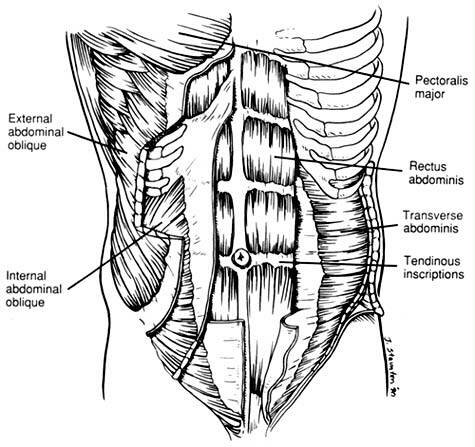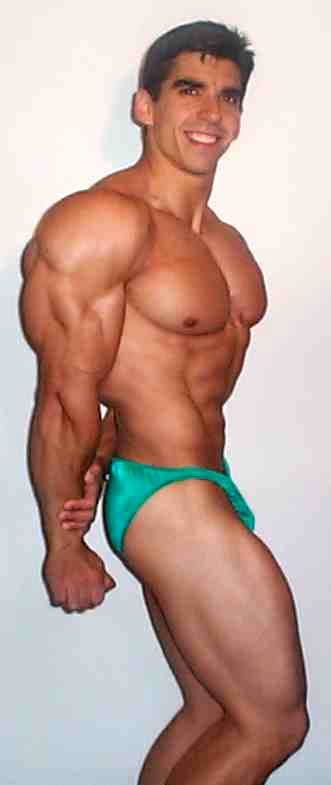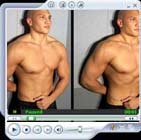| Part 1 | Part 2 |
It seems like the most often asked question when it comes to the subject of getting in shape is: "What is the best exercise to get your abs?" Typically, such question may be followed by comments like: "I do hundreds of sit-ups and crunches everyday but I still can't see them!" or "I do a lot of oblique work but I still have fat on my sides".
In this series of articles, best selling fitness author and National NPC bodybuilding competitor Hugo Rivera and fitness expert, IFBB Figure Professional, Marcy Porter join forces to finally provide an answer to the riddle on how to get the most desired and enviable muscle group in the world; the abs.

The Amazing Abs Of Marcy Porter.
ABS 101
First of all, everyone in this world has abs. Ask any student of college anatomy that has opened up a human body and analyzed what is inside. They will tell you that every human subject had abs.
So if we all have abs, then how come we can't see them? The reason for that is that there is a wall of fat that is preventing them from being visible. This leads to the first rule for getting abs:
Principle #1:
In Order To Get Abs, You Need To Decrease Your Body Fat Percentage.
There is no "if's" or "but's" about this. Too much body fat and you won't be able to see you abs.
In order for men to start seeing some of their abs they need to be at 10% or below. Women, on the other hands, start to see lines at 13% since women typically store body fat in other areas such as the hips and glutes.
Get Your Own Body Fat Tester Here...
Later in this series of articles we will describe how to lower body fat percentage, but for now, suffice it to say, a good nutrition program in conjunction with cardiovascular exercise and a good weight training routine that exercises your whole body and includes abdominal work are the key to long term fat loss.
Principle #2:
To have the best-looking abs, one needs to exercise them correctly and understand abdominal anatomy in addition to following principle #1.
Abdominal Anatomy
There Are Four Main Muscle Groups That Make Up The Full Abdominal Wall:
- The Rectus Abdominis (composed of upper and lower abdominals)
- The Oblique Muscles
- The Intercostal Muscles
- The Serratus Anterior
Rectus Abdominis Function & Exercises
The muscle that extends from the top of the pelvis to the sternum is called the rectus abdominis. This is the primary abdominal muscle, which when properly developed (assuming that the person has low enough body fat levels) will give the illusion of a six-pack. Its function is to pull the upper torso towards the hips when the body is only slightly flexed at the waist.
This is the reason why if you are doing a sit-up, any additional torso movement done past the initial 30 degrees from the floor will not stimulate the abs; instead the hips will be the ones that will complete the movement. Because of this, partial sit-ups performed with the torso moving up to 30 degrees and crunches are great allies in our quest to achieve great abs.

However, if you really want to maximally stimulate the abdominals, prevent lower back problems and get the most "bang for your buck" so to speak, then you need to also consider the fact that the anatomy of the rectus abdominis is such that if you do not bend your torso backwards by around 15 to 20 degrees then you won't be able to accomplish these things.
Since the floor only provides a flat surface, not only your abs will not get maximal stimulation, but also they will not learn how to properly contract and protect your back when your body is bent backwards (as is often the case when advanced bodybuilders perform exercises like standing military presses).
The only way to get around this is by investing on a swiss ball (also known as exercise ball). A swiss ball is a great small investment (they run for about $13-$15) as this apparatus will allow you to get the necessary backwards bend that your torso needs in order to maximally stimulate your abs.
So because of this, crunches performed on an exercise ball are the way in which I recommend you perform this exercise.
Get Your Own Exercise Ball Here...
Since the rectus abdominis also has muscles in the lower region that help maintain proper postural alignment, it becomes necessary to include reverse crunches performed on the swiss ball (make sure that you hold to a stationary sturdy object) as this exercise will allow you to go below the neutral (flat) position.
Another good lower abdominal exercise is the hanging leg raises. The key for maximal stimulation in this exercise is to roll the pelvis slightly backwards at the beginning of the movement.
Oblique Muscles Function & Exercises
The external obliques are the muscles at the sides of the waist. The external oblique complex actually consists of three layers of muscles: the internal obliques, the transverse obliques and external obliques. Together, these muscles contract to tilt the torso, as well as twist it, from side to side.
While a bodybuilder would not want massive obliques as this would take away from symmetry and give the illusion of a thick waist, these muscle do need to be trained in order to maintain ideal postural alignment.
A great exercise for these muscles is the side bends performed on a swiss ball. Another exercise that also needs to be performed for these muscles in order to exercise its rotating capabilities are the Russian Twists.
The Intercostal Muscles
The intercostals are the muscles of breathing that lie between the ribs and show as bands of muscle angling downward in the sides of the rib cage and the upper abdomen.
The intercostals come into play by flexing the torso and causing it to twist, so doing any type of twisting crunch on a swiss ball will stimulate this group maximally.
The Serratus Muscles
The serratus anterior muscles are the finger-like strands of muscle on the rib cage between the front abs and the lats. Their job is to depress the rib cage and also assist in bringing the upper arms from a position pointing directly up from the shoulders to one pointing directly below the shoulders. A good exercise that will stimulate these muscles is the one-arm cable crunches (using an overhead pulley). Principle #3:
Sets and Reps are dependent upon how advanced the person is.
As time goes by and one progresses, more sets can be added and repetition parameters can also be manipulated by adding weights to some exercises in order to target the fast twitch muscle fibers in the abs and thus create a six pack with deeper groves in between.
Adding weight to abdominal exercises will not give you a bloated stomach look.
Principle #4:
Unless you are training one day upper abs and the next day lower abs (a very advanced technique), training abs every day will typically lead to overtraining them.

The Amazing Physique of Hugo Rivera.
Therefore, unless you are doing upper abdominals one day and lower the next, you are better off training your abdominals for no more than 20 minutes at a time, 3 times per week on alternating days, as in Mon/Wed/Fri.
Principle #5:
As one gets more advanced, repetition tempo (the speed at which one performs the exercises) can also be altered in order to elicit a response.
Doing this will in turn stimulate more muscle fibers in the area which results in faster results!
Principle #6:
Do not train the obliques with low repetitions.
As a matter of fact, some people are so genetically gifted that their sides grow from little oblique work. In this case, oblique work should be completely taken out.
What Body Type Are You? Take The Test!
Principle #7:
For a smaller waist, try training the TVA muscle as well.
To train it, all you have to do is suck your stomach in. I'm serious; believe it or not, that is the purpose of that muscle. So by exhaling all of the air out of your lungs and bringing the navel as close as possible to your spine you will be training the TVA and thus creating the appearance of a smaller waist.
 |
Watch The Video
|
Because of the nature of this muscle, it can be trained every day at any time. Three sets of 30-second contractions should get you started.
Conclusion
Now that you know the 7 principles of AbSculpting, you can start implementing them in your routines. Next time, we will share with you some great routines that we've used to train our abs that are guaranteed to set your waist on fire.
For now, remember all of these principles and that no great abdominal wall can be created without a caloric deficient diet that consists of several small meals (5-8) a day. On part 3 of this series we will cover this subject in more detail.
Take care and train hard!
| Part 1 | Part 2 |
